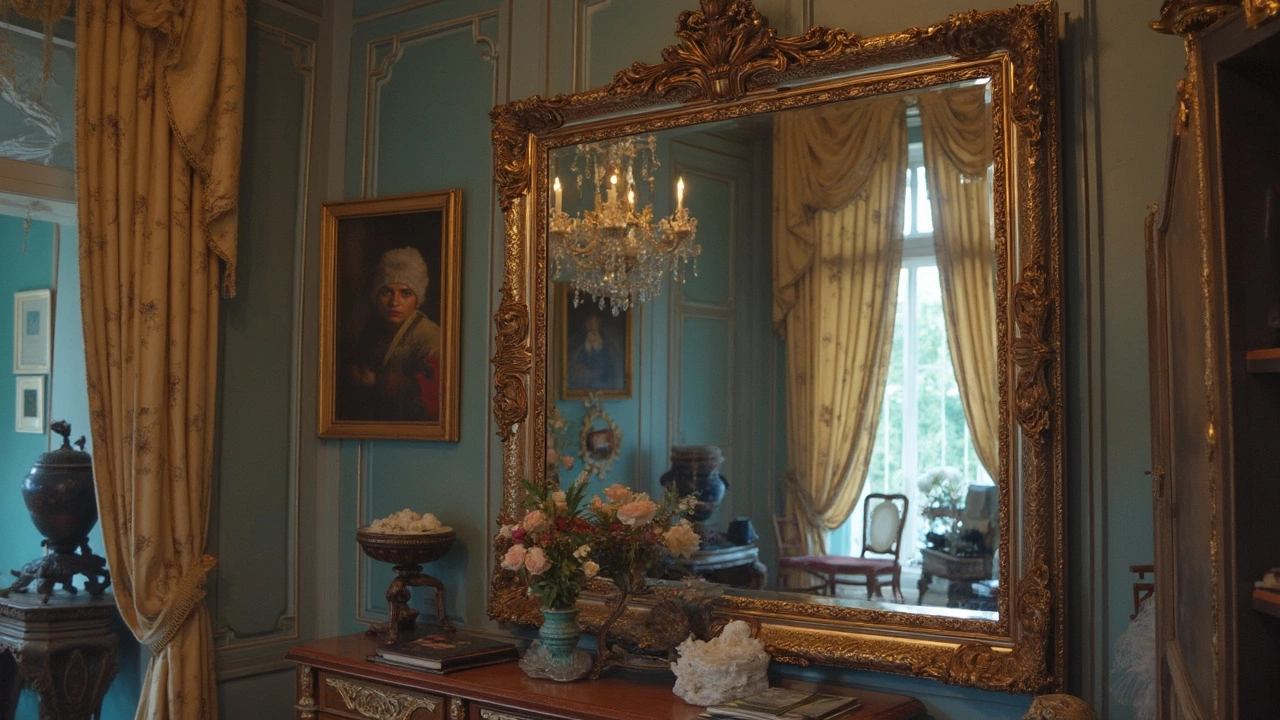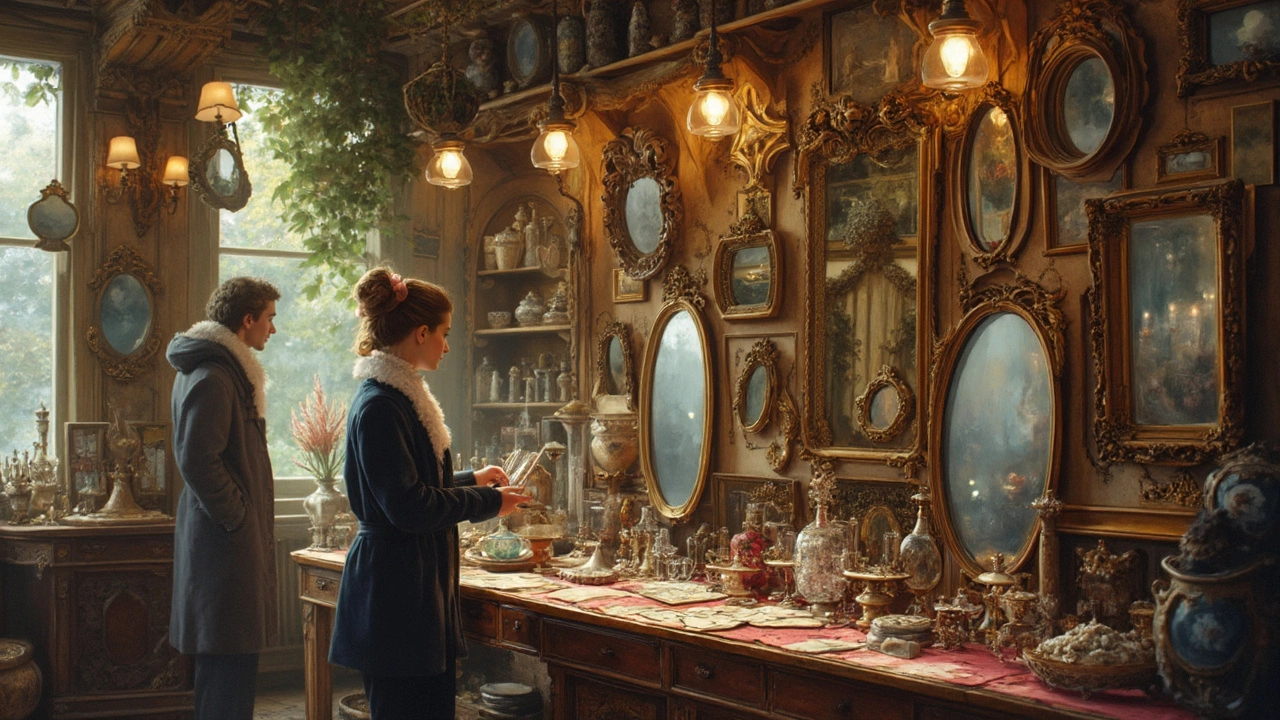Ever picked up a mirror, loved its vibe only to hang it at home and find it's like looking through a foggy window? Yeah, not the best surprise, right? When hunting for a good quality mirror, there’s more to it than a stylish frame. Seriously!
First off, take a look at the materials. A high-quality mirror will likely flaunt materials like copper-free silver backing that dodges corrosion, unlike cheap coatings that scream quick fix. Next comes the thickness. A mirror that's too thin can warp over time—it's science, or maybe gravity. Check that it's sturdy enough to resist the fun house distortions.
Alright, let's talk glass. Look for smooth, flawless glass. Wave goodbye to wavy reflections; those are a dead giveaway of skimpy glass or a wonky manufacturing process. It's all in the details, you know?
- Materials Matter
- Thickness Counts
- Glass Quality
- Reflective Coating
- Clarity and Reflection
- Physical Flaws and Distortions
Materials Matter
So, you’re in the market for a mirror, but before you swipe that card, let’s chat about what it’s made of. Because seriously, the materials can make or break your choice.
First and foremost, the backing of a mirror is where the magic—or disaster—can happen. High-quality mirrors often feature copper-free silver backing. This might sound a bit techie, but it just means the mirror's less likely to corrode, which is code for: it’ll look good longer. Mirrors with standard chemical silver coatings often age poorly, risking unsightly black edges or spots. Not exactly what you want for your bathroom centerpiece, right?
Then there’s the frame. A good frame isn’t just about the looks—although that matters too. Whether you’re into sleek metal or rustic wood, consider how it holds up over time. The durability of the material is key. If you’re placing your mirror in a high-moisture area, like a bathroom, opting for moisture-resistant materials can save you from heartache—and a soggy frame!
To keep things real, here's a quick peek at what typical mirror materials have to offer:
- Silver and Aluminum Backing: Silver is pricier and more reliable; aluminum's more budget-friendly but might not last as long.
- Frame Materials: Wood gives a warm look, but metal and resin offer better moisture resistance.
- Mirror Adhesives: Yes, even glue matters! Acid-free adhesives help prevent back damage.
Ultimately, not just any mirror will do. Knowing what it's made from allows you to understand how it’ll perform. And hey, who doesn’t want a quality mirror that can hang around for a while?
Thickness Counts
Okay, so why should you care about how thick a mirror is? Well, it turns out, the thickness of a mirror is like its backbone. A quality mirror generally comes in three standard thicknesses: 2mm, 3mm, and 5mm. Spoiler alert: thicker is better.
Let’s break it down. A 5mm thick mirror is often what you'll find in places that invest in long-lasting beauty, like hotels or design studios. It's less prone to flexing, which means it's less likely to give you that dreaded wavy reflection experience. Basically, it’s gonna stay wrinkle-free, unlike some of us.
Now, a 3mm mirror is your middle ground—solid, reliable, and suitable for most home needs. But be cautious about 2mm. These ultra-thin mirrors can save you some bucks but then laugh at you with those ‘fun house’ reflections over time or when hung over larger areas.
Thickness also affects durability. Ever lean a mirror against a wall, just to have a freakout moment when it sways or worse, cracks? Thicker mirrors carry more heft, giving them better stability. Less swaying, more staying put.
Glass Quality
So, let’s chat about why glass quality is a big deal when you’re picking a mirror. You’re looking for these little but super important details because they make all the difference in how your mirror looks and performs over time. You want it to reflect your radiant face, not some blurry version of you!
The first thing to eyeball is the glass surface. A high-quality mirror will have glass that’s smooth and totally free from any bubbles, waves, or distortions. If you see any kind of weird patterns or it looks like you're in a funhouse, that’s a no-go signal. Good glass should feel and look just about perfect with consistent clarity and no weird ripples or anything.
- Check for surface smoothness – run your hand lightly over it if possible.
- Stand back and look for wavy reflections; these usually suggest imperfect glass.
- Look close for any specks or bubble-like flaws. Quality glass should be spotless!
Another thing that often gets overlooked is the tint or color of the glass. A quality mirror should have clear glass without a greenish tint, which some cheap ones might have because of iron content in the glass. It's subtle, but that tint can affect how accurate reflections are.
And let's talk a bit about longevity. Higher quality glass generally lasts longer and holds up against mishaps like small scratches or general wear. You don’t want to baby your mirror more than necessary, right?
Remember, the quality of the glass can make or break your mirror experience. So when you’re shopping, keep a keen eye on these factors to ensure you pick a winner. After all, mirrors are an investment, and you deserve the best reflection possible!

Reflective Coating
Alright, so let's get to the heart of what makes a quality mirror actually work—its reflective coating. This stuff is like the secret sauce. If you're wondering why some mirrors look super sharp while others are more like a foggy memory, it's all about what’s behind the glass.
Good mirrors usually have a silver or aluminum coating. But it’s not just about slapping some metal on glass. The process matters. Silver coatings are often seen as top-tier because they reflect light better, giving you that crisp reflection you want from a mirror you trust. However, top-notch manufacturers have figured out how to do it without the metal fading or corroding over time, using protective layers that seal the deal.
Amazing stats? Some slick mirror brands boast a lifespan of over 20 years without losing clarity, thanks to their coating techniques. That's kind of a big deal. If you’re ever in a store and want to check out the reflective magic at play, try this: hold a pen up to the glass. A high-quality mirror will have the gap between the pen's reflection and tip barely noticeable. Lower grade mirrors will show a bigger gap because of the poorer coating.
- Look for copper-free silver backing, as it remains durable longer.
- Check the protective layers; they keep corrosion away.
- Aim for a mirror with a guarantee or warranty—it says the brand trusts their product.
So remember, when you’re mirror shopping, a closer look at the reflective coating might just make the difference between a keeper and a dud. Trust me, you’ll see the difference.
Clarity and Reflection
When it comes to mirrors, clarity and reflection are the real stars of the show. A clear, true reflection without distortion is the ultimate goal, right? So how do you know if you're getting the real deal?
First, stand a few feet back from the mirror and move from side to side. The reflection should remain consistent and undistorted. If it feels like you're in a carnival house of mirrors, keep looking. A quality mirror offers an accurate reflection, which some call the 'silver reflection.'
Here's a neat trick: hold a pencil or any straight object up to the mirror. The reflection should line up perfectly with the object. If there’s a gap or double image, the mirror might be poor quality.
Next, natural light is a good friend. Look in the mirror under different lighting to see if the reflection is true to life. Sometimes artificial lights can hide faults that only natural light reveals.
Also, check the reflective coating. The back of a good quality mirror usually has a pristine and uniform coating. A patchy or thin coating might mean that the reflection won't stay sharp for long.
You might not know this, but the type of metal used for coating can affect clarity. Silver-backed mirrors are known for bright, crisp reflections, that's why they're popular in quality home decor. Avoid those with overly cheap reflective surfaces, as they degrade faster.
Last but not least, if you're into science-y stuff, here's a fun fact: sometimes mirrors are laboratory-tested for reflectivity levels, often measured as a percentage. Higher reflectivity levels mean clearer and more truthful reflections. It's not everyday purchase info but cool to know!
Ensuring the clarity and reflection is spot on can make all the difference in a room's aesthetics. A mirror's job is to reflect reality, without adding its own spin on things – that's your job!
Physical Flaws and Distortions
Alright, so let’s get into something super important but often overlooked—physical flaws and distortions. Ever noticed how some mirrors seem to bend everything in sight? That’s a sign of warping, and it’s a no-go for a quality mirror. This isn’t just a nitpick; over time, such distortions can actually throw off your home’s vibe and even mess with your daily routine when you can’t tell if you’ve got spinach in your teeth or not!
Checking for flaws is easier than you might think. When shopping for a mirror, stand directly in front of it and move side to side. If you notice the image bending, the mirror isn’t flat. A small ripple might seem like nothing in the store but can be super obvious at home.
Remember, a decent mirror not only reflects your style but should do so clearly. Look for cracks or chipping along the edges too. These can be signs of mishandling or poor quality control.
If you’re grabbing a mirror online, reviews are your best friend. Real people will spill the tea on whether the item arrived with any dings or if the reflection is a funhouse experience. It's like having an instant shopping buddy!
Here’s a quick table that might help:
| Mirror Quality | Indicators |
|---|---|
| High Quality | Clear, consistent reflection, no edge chipping |
| Low Quality | Distortions, noticeable bends, chipped edges |
In short, don't settle for a mirror that seems to be more creative about its reflections than you'd like. A little diligence goes a long way in finding a mirror that matches your needs while staying true to how things actually look.

